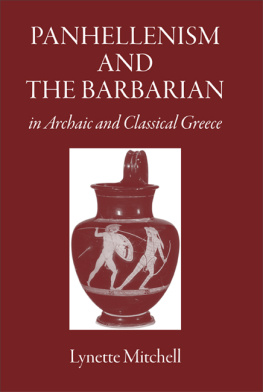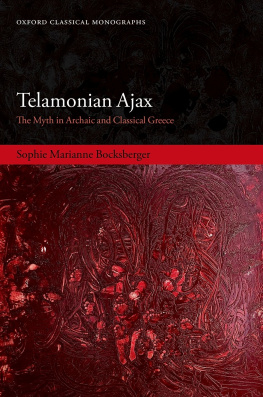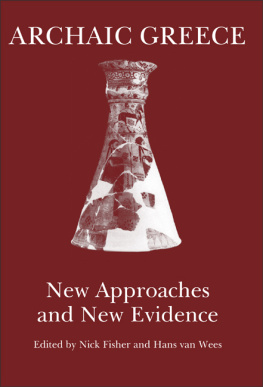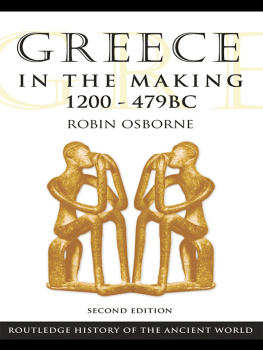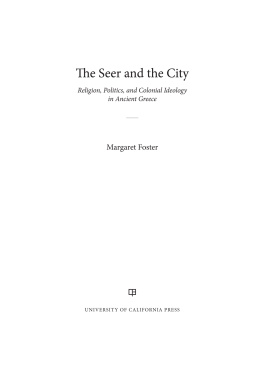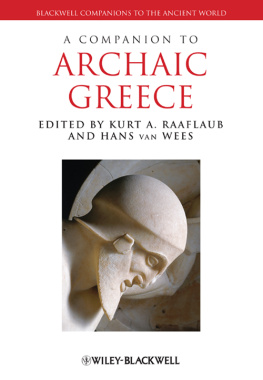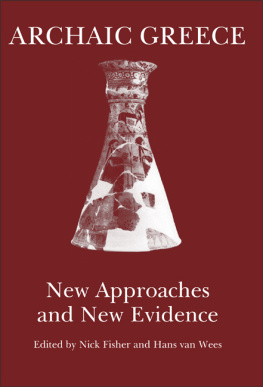
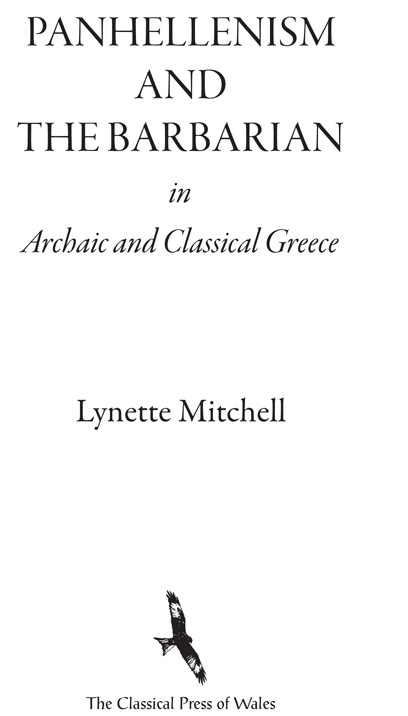
First published in 2007 by
The Classical Press of Wales
15 Rosehill terrace, swansea SA1 6JN
tel: +44 (0)1792 458397
Fax: +44 (0)1792 464067
www.classicalpressofwales.co.uk
Distributed by:
Oxbow Books,
10 Hythe Bridge street,
Oxford OX1 2EW
Tel: +44 (0)1865 241249
Fax: +44 (0)1865 794449
Distributor in the United states of America:
The David Brown Book Co.
PO Box 511, Oakville, CT 06779
Tel: +1 (860) 945-9329
Fax: +1 (860) 945-9468
2007 The author
All rights reserved. No part of this publication may be reproduced, stored in a retrieval system, or transmitted, in any form or by any means, electronic, mechanical, photocopying, recording or otherwise, without the prior permission of the publisher.
ISBN 978-1-905125-14-2
A catalogue record for this book is available from the British Library
Typeset by Ernest and Andrew Buckley, Clunton, Shropshire
Printed and bound in the UK by Gomer Press, Llandysul, Ceredigion, Wales

The Classical Press of Wales, an independent venture, was founded in 1993, initially to support the work of classicists and ancient historians in Wales and their collaborators from further afield. More recently it has published work initiated by scholars internationally. While retaining a special loyalty to Wales and the Celtic countries, the Press welcomes scholarly contributions from all parts of the world.
The symbol of the Press is the Red Kite. This bird, once widespread in Britain, was reduced by 1905 to some five individuals confined to a small area known as The Desert of Wales the upper Tywi valley. Geneticists report that the stock was saved from terminal inbreeding by the arrival of one stray female bird from Germany. After much careful protection, the Red Kite now thrives in Wales and beyond.
For Stephen and James
CONTENTS
ACKNOWLEDGEMENTS
This project was started during my British academy Post-doctoral Fellowship hosted by Oriel College, Oxford, and both the British academy and Oriel College have continued to support it, particularly through the hospitality and kindness of Professor ernst nicholson of Oriel, and a British academy small research grant which allowed me to travel regularly to Oxford, and to visit the national archaeological museum in athens, and so to complete the monograph.
The bulk of the book, however, was written in exeter, and I owe a heavy debt of gratitude to colleagues for friendship and encouragement, and especially to stephen mitchell, John Wilkins, richard seaford and david Braund, who read and commented on drafts. Peter rhodes, robin Osborne, robert Parker and especially Chris Pelling also read the whole for me at various stages, and were generous with their time and their comments. in addition to all these, there are the many friends without whose kindness and support this book would not have seen the light of day, in particular Wendy maull, Jenny hocking, Caroline huxtable and shane Coombs. especial thanks, however, must go to my family, to stephen and to James. This book represents a poor return for the way in which they have cherished and cared for me, but I dedicate it to them, with thanks.
LGM
May 2006
University of Exeter
ABBREVIATIONS
The following abbreviations for ancient authors and their works should be noted:
| [Apoll.] | [Apollodorus], Bibliotheca |
| Q.C. | Quintus Curtius, History of Alexander |
| Serv. Dan. | Servius Danielis |
Periodicals are abbreviated as in LAnne Philologique, with the usual English divergences (e.g. AJP for AJPh). Note also the following abbreviations for modern sources (for full publishing details of items listed here, except standard collections of texts and reference works, refer to the bibliography):
| ARV 2 | J.D. Beazley, Attic Red-figure Vase-painters, 2nd edn |
| Buck | C.D. Buck, The Greek Dialects, revised |
| CAH | Cambridge Ancient History |
| Campbell | D.A. Campbell, Greek Lyric: Sappho and Alcaeus, |
| revised edition |
| Davies EGF | M. Davies, Epicorum Graecorum Fragmenta |
| Davies PMGF | M. Davies, Poetarum Melicorum Graecorum |
| Fragmenta |
| Der neue Pauly | H. Cancik and h. sdmeider (eds.) Der neue Pauly. |
| Enzyklopdie der Antike |
| DK | H. Diels and W. Kranz, Fragmente der Vorsokratiker 6 |
| Fornara | C.W. Fornara, Archaic Times to the End of the Peloponnesian War |
| FGrHist | Jacoby, Die Fragmente der griechischen Historiker |
| HCT | Aw. Gomme, a. Andrewes and K.J. Dover, A Historical Commentary on Thucydides, 5 vols. |
| HW | WW. How and J. Wells, A Commentary on Herodotus, |
| 2 vols. |
| IG | Inscriptiones Graecae , 14 vols. |
| InvM | O. Kern, Die Inschriften von Magnesia am Maeander |
| IPriene | F. Hiller, Inschriften von Priene |
| ISE | L. Moretti, Iscrizioni Storiche Ellenistiche |
| Jouan/van Looy EF | F. Jouan and H. van Looy, Euripide , vol. 8 (4 |
| vols.):Fragments |
| Kassel/Austin PCG | R. Kassel and C. Austin (eds.) Poetae Comici Graeci, |
| 8 vols. |
| Kock | Kock, Comicorum Atticorum Fragmenta, 3 vols. |
| LIMC | Lexicon Iconographicum Mythologiae Classicae |
| Lobel/Page | E. Lobel and D-l. Page, Poetarum Lesbiorum Fragmenta |
| ML | R.Meiggs and D.M. Lewis, A Collection of Greek Historical |
| Inscriptions to the End of the Fifth Century, revised edn |
| NAM | National Archaeological Museum, Athens |
| Nauck TrGF | A. Nauck, Tragicorum Graecorum Fragmenta, 2nd edn. |
| OCD3 | S. Hornblower and A. Spawforth (eds.) The Oxford Classical |
| Dictionary, 3rd edn |
| OCT | Oxford Classical Texts |
| Page FGE | D.L. Page, Further Greek Epigrams |
| Page PMG | D.L. Page, Poetae Melici Graeci |
| Page SLG | D.L. Page, Supplementum Lyricis Graecis |
| Radt TrGF | S. Radt, Tragicorum Graecorum Fragmenta |
| RE | Real-Encyclopdie der klassischen Altertumswissenschaft |
| RO | P.J. Rhodes and R. Osborne, Greek Historical Inscriptions, |
| 479323 BC |
| Staatsvertrge | H. Bengtson, Die Staatsvertrge des Altertums, 3 vols., 2nd edn |
| Syll.3 | W. Dittenberger, Sylloge Inscriptionum Graecorum, 3rd edn |
| Tod | M. Tod, A Selection of Greek Historical Inscriptions, 2 vols. |
| West | M.L. West, Greek Lyric Poetry |
| West IE/IE2 | M.L. West, Iambi et Elegi Graeci I/II , 2nd edn |
| West ThPhF | M.L. West, Theognidis et Phocylidis Fragmenta et Adespota |
| Quaedam Gnomica |
When referring to epigraphical sources, = does not always mean direct equivalence, but that the section of the inscription discussed can be found in both places.
Next page
